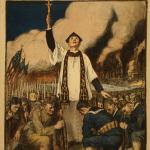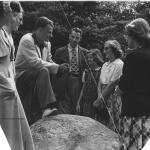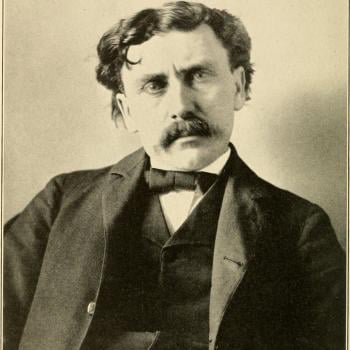In 2005, George Clooney starred in Good Night, and Good Luck, a decent film about broadcaster Ed Murrow’s struggle against Senator Joe McCarthy, set in 1953. A careful viewer would note a scene in an office where you see a water bottle sitting on a desk, in a way that water bottles did not in 1953, any more than did Macbooks or Starbucks cups. The interesting thing is not that somebody left the bottle there, but that nobody else noticed it was odd, or anachronistic. They assumed that what was normal today was normal back in that earlier era. We see things as we expect them to be, according to our own familiar realities. And whether we recognize it or not, those realities change over time. Put another way, we see things not as they are, but as we are. In the great scheme of things, the bottle is a trivial goof, but it serves as a metaphor for how films treat history, and it offers lessons for how we might use cinema as a means of teaching that history.
I recently posted about choosing films to include in a course about the Cold War – or, indeed, in a specialized course on Cold War cinema. Films are an incredible resource for teaching about earlier eras, and in representing the attitudes and beliefs of the time. On a topic like the Second World War, they are so valuable as to be overwhelming, and probably essential. Perhaps their greatest function is in challenging the myths and illusions that a modern audience will have about how people thought and acted Way Back When. If you think the Greatest Generation that went to war in 1941 existed in a world of conformity, automatic submission to authority, of sexual repression and ignorance – unlike the daring and experimental 1960s – try watching Hellzapoppin’, Miracle at Morgan’s Creek, and Hail the Conquering Hero, just for a start. No, Monty Python did not invent surreal, off the wall, drug-fueled humor: see Hellzapoppin’.
In the context of the Cold War, a viewing of Dr. Strangelove will teach you far more about nuclear policies and attitudes c.1962 than a hundred scholarly lectures. Even better, such a film had an immense effect on real world public attitudes, so it became a historical force in its own right. In its way, the same is true of The Manchurian Candidate, although that was effectively buried for some years after its original success.
But let me add one huge caveat here. If you are using a film to teach about a particular period, always, always, use strictly contemporary films rather than later items looking back at the period in question. That applies even if the later films are artistically superb, and the contemporary ones are not so much. If, for instance, you are watching a film about (say) the nuclear confrontation c.1962, always choose a film from round about that date – within three or four years, say – rather than a magnificent and star-studded piece from fifty or sixty years later.
The reason is obvious enough. When you watch a strictly contemporary film from the era in question, you learn so much about the period in general, rather than the specific theme addressed. You learn about everyday habits and attitudes, in matters like (obviously enough) gender and race and class, but also in how people smoke, or drink, or drive, or talk, or discuss things, or treat authority. That can be a goldmine of information for social and cultural history. Also, just as obvious, you learn from the evidence of things not seen. Around 1960, for instance, US films with any black characters whatever tended to show fairly liberal interactions, because the decision to use black figures was daring and “liberal” in itself. In other more routine films, minorities are conspicuous by their absence. Demeaning stereotypes are bad enough, but the total exclusion is far more damning.
Now move forward to a film made in 2021, say, about that earlier era, such as the late 1950s. The researchers can try and do a just magnificent job in making sure that the historical narrative is about right, that characters are driving appropriate cars, and are acting according to the standards of the time, but rarely will they get all that perfect, or even acceptable.
A 2021 film is going to have 2021 sensibilities, as the film-makers construct them. Nowhere is that more true than in matters of gender. A film made today about the 1950s is duty bound not just to include prominent female characters, but to portray them in ways that a modern audience expects and approves. At least some women in the film are going to be plucky or boundary-breaking, whether or not there is any warrant for that in the circumstances surrounding the actual historical event portrayed. There is an overwhelming urge not just to diversify those events, but to retroject modern attitudes, often unconsciously – just think of Ed Murrow’s water bottles. A 2021 audience watching such a film will see the approved messages, and the resulting film might be a total success on its own terms. But what it is not showing is what people thought about such things at the time – or, in other words, the historical context.
To take one point that might seem minor but isn’t, everyone knows that the vast majority of Americans smoked in the 1960s, say, and you can show people smoking in a modern reconstruction. But unless you watch the films of the time, you have no idea of the rituals and gestures and movements that accompanied smoking, the many and various ways in which people held or offered cigarettes, used smoking to win favor or to insult inferiors, or (often) used smoking a a major portion of sexual interaction and flirting. Horribly as we may think in retrospect, this was a major part of social interaction generally, in a society that was built on smoke. It is basically impossible to reconstruct that world accurately without watching many, many films of the time, of all different sorts and levels.
Going back to the post I did about Cold War movies, there are a series of films from the past decade or so, such as Bridge of Spies, which I love as a film in its own right. It describes famous events involving real named people, in a way that students might find comprehensible and attractive. Even so, I would never use it as a classroom resource. It plays havoc with historical fact and chronology, but more to the point, it represents the world of the 1960s as seen in a distant mirror, and not in the light of the time itself. I will never knowingly show disrespect to anything involving the Coen brothers, but I will not use this in a classroom. I would much rather use something strictly from that era, with all its own errors and lack of correctness and sensitivity, and use those features as teaching opportunities.
Let me draw a distinction that is fundamental to historical research and writing. A film about an event made fifty or sixty years later may be a heroic attempt to portray that happening, but it is a secondary source, unless it reflects the direct experience of some participant. Bridge of Spies is based on secondary historical research by writers of a later generation altogether. So is Good Night and Good Luck, or The Courier.
In contrast, a film made strictly at the time, or very shortly afterward, is a primary source for studying that era. It would be ludicrous, for instance, to take From Russia With Love (1963) as a faithful narrative of events in the Cold War. But as a document for the social and cultural history of the era, it is a primary source. The film in itself is an unmediated primary document, and can be analyzed by students in that way. The same applies to strictly contemporary Cold War films like Dr Strangelove or Advise and Consent.
The 1970 film M*A*S*H film notionally concerns the Korean War, but it tells us nothing whatever about that conflict. It is richly informative about American society, culture, values, and gender attitudes as they existed in 1970, and can serve as a primary source for that topic.
Viewed in this way, a film need not have the slightest pretensions to be ”historical,” but can still offer a great deal of historical evidence that is difficult to find in other ways. Just on a later period I have taught about quite a bit, there is a really important 1979 film called North Dallas Forty, starring Nick Nolte, which many would count among the greatest American films ever made about sport. Nobody, to my knowledge, has ever claimed it is a historical film, or a film about history. But if you watch it today, you will be stunned by the attitudes to gender and sexuality, and what today – not then – we call sexual harassment. One of the footballer characters regularly behaves in ways that today would not just be disapproved but which would immediately invite massive lawsuits, and felony charges. At the time, he is depicted as an obnoxious jerk on an epic scale, but there is no sense of an urgent need to intervene and stop his extreme harassing behavior, as there assuredly would be today. You can only imagine how modern sensibilities would demand that this whole theme be treated today. But the virtue of watching the original 1979 film is not that we approve the gross behavior, but we learn – in open-mouthed astonishment – what was regarded as acceptable in that inconceivably distant historical epoch, shortly after the earth cooled, when Joe Biden was only in his second term in the US Senate. Don’t get me started on the characters’ casual homophobia.
The film itself, in other words, is a prime historical document on that era, and indeed a major primary source for studying the values and gender attitudes of the mid-late 1970s. A 2021 film made retrospectively about the football world of 1979 would be a totally different animal. If you are teaching a course on the 1970s, or on the history of attitudes to gender and sexuality, or indeed the history of sport, the original North Dallas Forty is a stunning resource.
Repeat after me the essential words of H. E. Bates: “The Past is a different country – they do things differently there.” I assume that all credible historians already have these words tattooed on an arm. What do you mean, you don’t?













